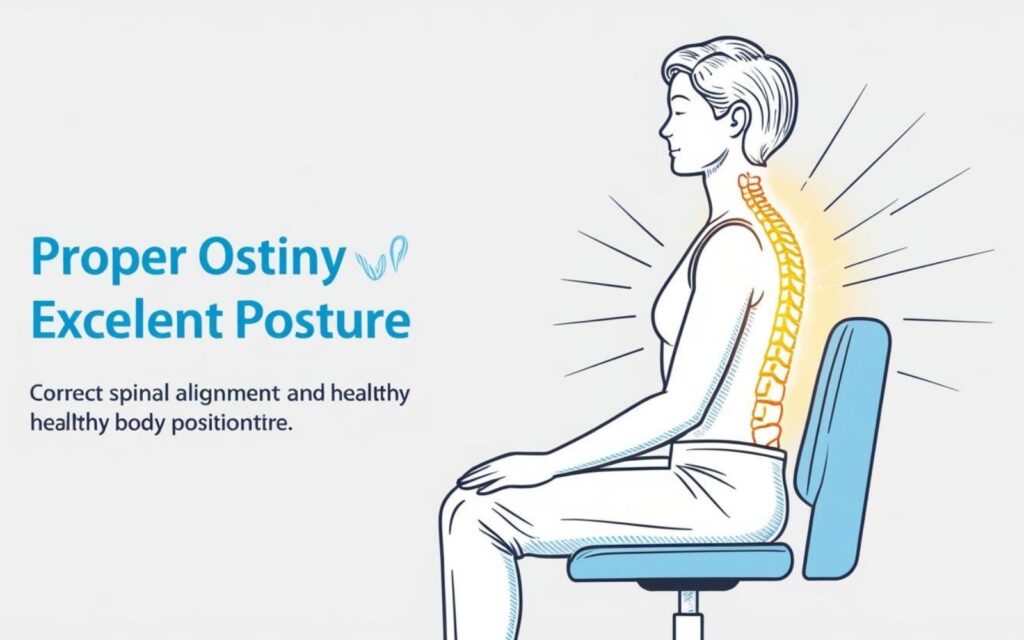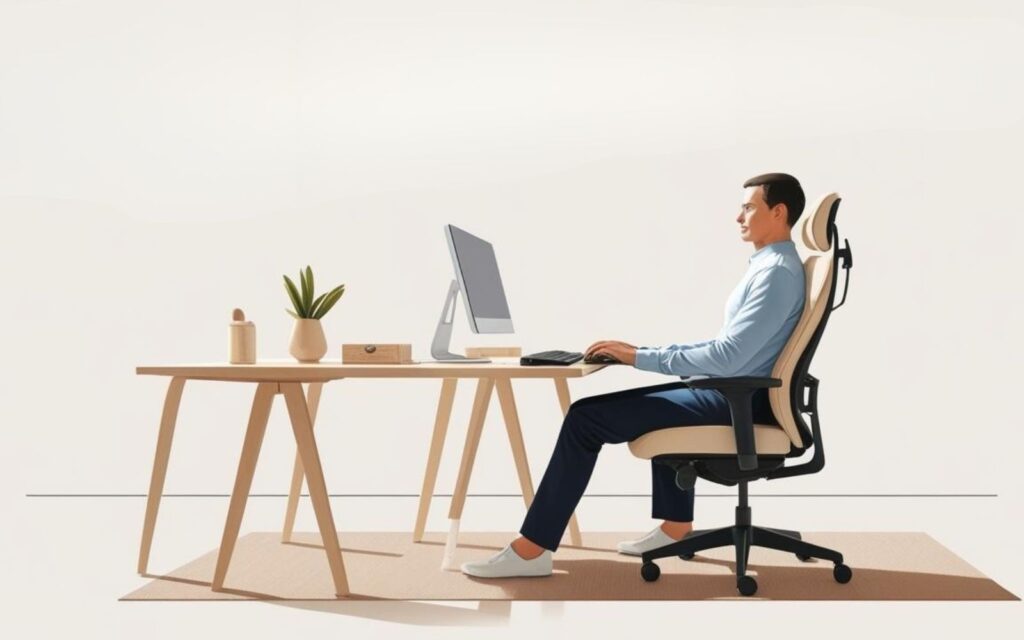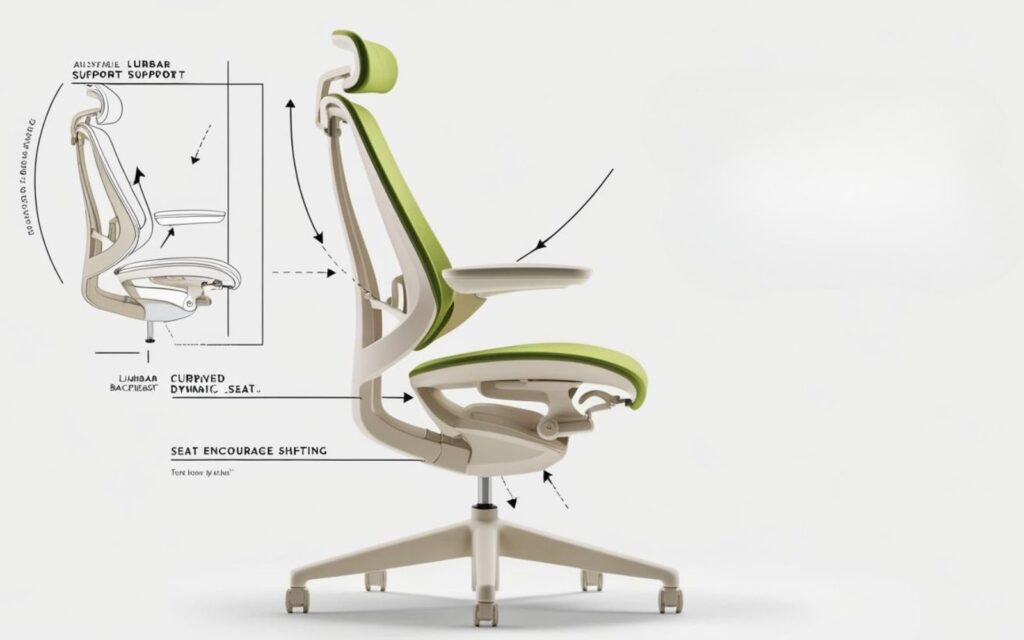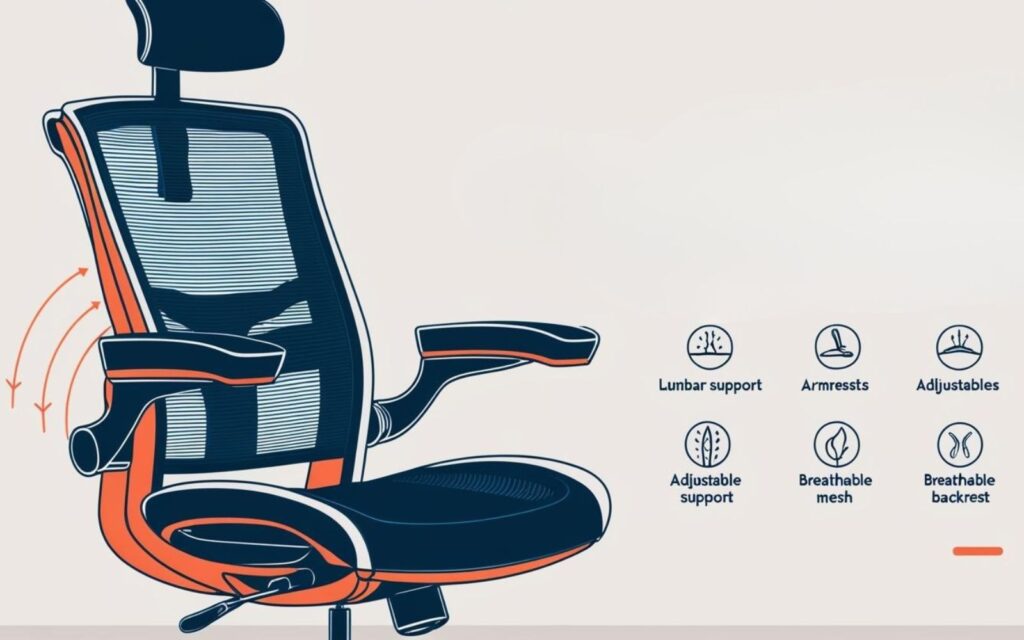How Ergonomic Chairs Reduce Workplace Strain: Your Key to a Healthy Work Environment

Have you ever felt that familiar ache in your lower back or tension creeping into your shoulders after a long day at work? Workplace discomfort is a common issue – especially for those who spend hours sitting.
The good news? Ergonomic chairs are designed to tackle this exact problem. But how ergonomic chairs reduce workplace strain? And how can they prevent injuries caused by prolonged sitting, poor posture, and repetitive motions?
Let’s break it down and explore various ergonomic solutions.
Key Takeaways
- Ergonomic chairs help maintain proper posture and align the spine, reducing stress on your musculoskeletal system.
- Features like adjustable lumbar support and armrests ease tension and help you sit comfortably for extended periods.
- Proper ergonomic design can prevent repetitive strain injuries and work-related musculoskeletal disorders (WMSDs).
- Workplace ergonomics improves productivity, reduces fatigue, and improves mental health.
- Implementing ergonomic strategies creates a healthy work environment that promotes employee well-being.
Now, let’s dive into how ergonomic chairs create a more productive and healthier workday!
Understanding Workplace Strain

Workplace strain is a common issue that affects many employees, causing discomfort, pain, and decreased productivity.
Understanding workplace strain’s causes and effects is essential to prevent and mitigate its impact.
What are Repetitive Strain Injuries?
Repetitive Strain Injuries (RSIs) occur when a person performs repetitive tasks, such as typing, lifting, or bending, which can cause strain on the muscles, tendons, and joints.
These injuries can lead to musculoskeletal disorders, including carpal tunnel syndrome, tendonitis, and bursitis. Proper ergonomic practices, such as taking regular breaks, stretching, and maintaining correct posture, can help prevent RSIs.
Incorporating ergonomic chairs and other ergonomic solutions can significantly reduce the risk of developing these painful conditions.
The Impact of Workplace Injuries on Employees and Employers
Workplace injuries can have a significant impact on both employees and employers. Employees may experience pain, discomfort, and decreased productivity, leading to absenteeism and reduced job satisfaction.
For employers, the consequences include increased costs, such as workers’ compensation claims, medical expenses, and lost productivity.
Implementing ergonomic practices and providing a safe and healthy work environment can help reduce the risk of workplace injuries and promote a positive and productive work culture.
Employers can create a healthier and more efficient workplace by investing in ergonomic chairs and educating employees on proper ergonomic practices.
How Ergonomic Chairs Reduce Workplace Strain

How ergonomic chairs reduce workplace strain by improving posture, easing back pain, and boosting comfort for a healthier, more efficient workspace is discussed below:
1. Supports Proper Posture and Prevents Poor Sitting Habits

One of the primary ways ergonomic chairs reduce workplace strain is by supporting good posture and sitting for prolonged periods with poor posture-like slouching or craning your neck-can strain the lumbar spine, shoulders, and neck.
You can maintain proper body mechanics and prevent these issues by adhering to ergonomic principles.
How ergonomic chairs help:
- Adjustable backrest: Promotes a neutral spine position and supports the natural curve of your back through ergonomic adjustments.
- Headrest: Reduces neck strain by supporting your head, especially during breaks.
- Seat height adjustment: Keeps your feet flat on the floor, with knees at a 90-degree angle, promoting a natural posture.
Maintaining proper body mechanics while sitting reduces the risk of musculoskeletal injuries and related injuries like neck pain and carpal tunnel syndrome.
2. Provides Adequate Lumbar Support to Protect Your Lower Back

With an ergonomic design, proper lumbar support ensures your lower spine does not curve unnaturally, preventing long-term muscle tension and work-related musculoskeletal disorders.
Ergonomic chairs have built-in lumbar support to stabilize your lower back and prevent slouching.
Why lumbar support matters:
- Prevents excessive force on your spine with ergonomic features.
- Keeps your pelvis aligned, avoiding awkward postures that cause pain.
- Reduces the likelihood of work-related injuries like lower back pain.
Proper lumbar support allows you to work comfortably and prevent long-term damage to your musculoskeletal system.
3. Reduces Strain on the Neck, Shoulders, and Wrists

Repetitive tasks like typing, scrolling, or sitting at your desk for prolonged periods can lead to repetitive strain injuries in your upper body.
These injuries include carpal tunnel syndrome and neck strain, which can be mitigated through ergonomic interventions.
How ergonomic chairs reduce upper-body strain:
- Adjustable armrests: Keep your shoulders relaxed and arms at the right height, reducing tension.
- Reclining backrest: Allows small position changes throughout the day to relieve pressure on the neck and shoulders.
When paired with ergonomic practices like keeping your computer screen at eye level and using an external mouse, these solutions help create a more productive work environment and reduce discomfort.
4. Encourages Movement to Prevent Stiffness

Sitting in a static position for too long can cause your muscles to stiffen, leading to fatigue and soreness.
Ergonomic chairs are designed to promote movement and flexibility, offering significant ergonomic benefits.
Features that promote movement:
- Swivel base: Prevents awkward twisting and unnecessary movements when reaching for items.
- Ergonomic adjustments: Allow for personalized settings to enhance comfort and support, promoting better posture and reducing strain.
- Reclining and tilting functions: Let you lean back for brief breaks, which can help stretch your muscles and maintain a neutral position.
Regularly changing positions and taking short movement breaks can significantly improve musculoskeletal health.
5. Improves Blood Circulation and Reduces Fatigue

Poor circulation is a common problem when sitting for extended periods. It can lead to swollen legs, muscle fatigue, and poor concentration.
Ergonomic chairs are designed to support healthy blood circulation and reduce physical strain, offering significant ergonomic benefits.
How they help:
- Waterfall seat edge: A seat with a curved front prevents pressure on the back of your thighs, encouraging better circulation.
- Ergonomic adjustments: Features like seat height adjustment ensure your legs remain at a 90-degree angle, keeping your feet grounded.
By improving circulation, ergonomic chairs reduce muscle fatigue and promote overall well-being.
6. Reduces the Risk of Repetitive Strain Injuries and Work-Related Musculoskeletal Disorders

Repetitive motions, poor seating posture, and long periods of sitting contribute to work-related injuries and musculoskeletal disorders.
Ergonomic interventions, such as ergonomic chairs, can significantly reduce these risks.
Common workplace injuries:
- Carpal tunnel syndrome from poor wrist alignment.
- Neck pain due to a poorly positioned computer monitor.
- Lower back pain from insufficient chair adjustments and lack of ergonomic solutions.
Employees can prevent repetitive strain injuries and reduce their risk of developing chronic conditions by implementing proper ergonomic design and strategies.
Creating a Healthy Workspace

A healthy workspace is essential for preventing workplace injuries and promoting employee well-being. Here are some tips for creating a healthy workspace:
Evaluating Your Workspace for Ergonomic Risks
Evaluating your workspace for ergonomic risks is crucial for preventing workplace injuries. Here are some steps to follow:
- Assess Your Workspace: Take a close look at your workspace and identify potential ergonomic risks, such as poor lighting, inadequate seating, and repetitive tasks. Consider how your current setup might be contributing to discomfort or strain.
- Identify Risk Factors: Identify risk factors, such as prolonged sitting, poor posture, and repetitive motions, that can contribute to workplace injuries. Recognize the signs of strain and discomfort early to address them promptly.
- Implement Ergonomic Solutions: Implement ergonomic solutions, such as ergonomic chairs, proper lighting, and regular breaks, to reduce the risk of workplace injuries. Ensure that your chair provides proper lumbar support and that your workstation is set up to maintain an appropriate posture.
- Provide Training: Train employees on proper ergonomic practices, such as proper lifting techniques and maintaining correct posture. Educate your team on the importance of ergonomics and how to apply these principles in their daily tasks.
- Monitor and Evaluate: Monitor and evaluate the effectiveness of ergonomic solutions and make adjustments as needed. Regularly review your workspace setup and make changes to improve comfort and reduce strain.
By following these steps, you can create a healthy workspace that promotes employee well-being and reduces the risk of workplace injuries.
Investing in ergonomic chairs and educating employees on proper ergonomic practices can lead to a more productive and satisfied workforce.
7. Promotes Mental Health and Reduces Stress

When your body feels good, your mind follows suit. Sitting in an uncomfortable chair for hours can cause frustration, stress, and a lack of focus.
An ergonomic work environment provides physical and mental health benefits, highlighting the ergonomic benefits of using such chairs.
Mental health benefits of ergonomic chairs:
- Reduced physical strain leads to better focus and mood.
- A comfortable setup creates a more enjoyable and healthy workplace.
- Proper support can alleviate anxiety linked to chronic discomfort through ergonomic interventions.
An ergonomic chair can be key in creating a balanced and productive work environment where employees feel valued and supported.
8. Prevents Future Injuries with Ergonomic Practices

Prevention is better than cure. Investing in ergonomic furniture and educating employees on ergonomic principles can prevent future injuries.
Key prevention tips:
- Encourage proper sitting posture with the chair’s backrest fully supporting your back and make necessary ergonomic adjustments.
- Keep shoulders relaxed and avoid awkward postures when working.
- Position your computer screen at eye level to prevent neck strain.
You can build a healthy work environment that reduces work-related musculoskeletal disorders by combining proper ergonomic design with educating employees on proper lifting techniques and repetitive motion avoidance.
Summary
Ergonomic chairs are designed to reduce workplace strain by supporting proper posture, providing adequate lumbar support, and encouraging healthy movement.
With adjustable armrests, headrests, and waterfall seat edges, these chairs help prevent musculoskeletal symptoms, improve blood circulation, and enhance mental and physical well-being.
By adopting workplace ergonomics and ergonomic strategies, you can prevent repetitive strain injuries, enhance focus, and create a healthy work environment where productivity thrives due to the ergonomic benefits.
Frequently Asked Questions
How Do Ergonomic Chairs Prevent Work-Related Injuries?
Ergonomic chairs support the spine’s natural alignment, reducing pressure on joints and muscles.
Features like lumbar support, adjustable armrests, and a reclining backrest prevent musculoskeletal disorders and repetitive strain injuries through ergonomic interventions.
What Is the Best Sitting Posture to Reduce Strain?
The best posture involves keeping your feet flat on the floor, knees bent at a 90-degree angle, and your back supported by the chair’s backrest to maintain a neutral spine position, following ergonomic principles.
Can Ergonomic Chairs Help with Carpal Tunnel Syndrome?
Yes, they can. By positioning the armrests and seat correctly, ergonomic chairs reduce pressure on the wrists and promote better arm alignment, which can prevent carpal tunnel syndrome through ergonomic adjustments.
How Can Employers Encourage Ergonomic Practices?
Employers can educate employees on ergonomic principles, provide ergonomic specialists to conduct workplace assessments and ensure that office equipment, including computer monitors and desks, supports a neutral position.
Are Ergonomic Chairs Worth the Investment?
Absolutely. While they may cost more upfront, ergonomic chairs reduce work-related injuries, prevent future injuries, and boost productivity, leading to long-term savings and a healthier workforce.





One Comment